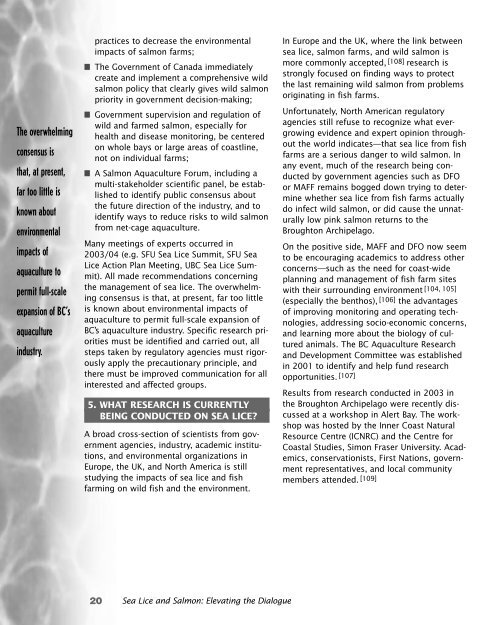Sea Lice AND Salmon - Farmed And Dangerous
Sea Lice AND Salmon - Farmed And Dangerous
Sea Lice AND Salmon - Farmed And Dangerous
Create successful ePaper yourself
Turn your PDF publications into a flip-book with our unique Google optimized e-Paper software.
The overwhelmingconsensus isthat, at present,far too little isknown aboutenvironmentalimpacts ofaquaculture topermit full-scaleexpansion of BC’saquacultureindustry.practices to decrease the environmentalimpacts of salmon farms;■ The Government of Canada immediatelycreate and implement a comprehensive wildsalmon policy that clearly gives wild salmonpriority in government decision-making;■ Government supervision and regulation ofwild and farmed salmon, especially forhealth and disease monitoring, be centeredon whole bays or large areas of coastline,not on individual farms;■ A <strong>Salmon</strong> Aquaculture Forum, including amulti-stakeholder scientific panel, be establishedto identify public consensus aboutthe future direction of the industry, and toidentify ways to reduce risks to wild salmonfrom net-cage aquaculture.Many meetings of experts occurred in2003/04 (e.g. SFU <strong>Sea</strong> <strong>Lice</strong> Summit, SFU <strong>Sea</strong><strong>Lice</strong> Action Plan Meeting, UBC <strong>Sea</strong> <strong>Lice</strong> Summit).All made recommendations concerningthe management of sea lice. The overwhelmingconsensus is that, at present, far too littleis known about environmental impacts ofaquaculture to permit full-scale expansion ofBC’s aquaculture industry. Specific research prioritiesmust be identified and carried out, allsteps taken by regulatory agencies must rigorouslyapply the precautionary principle, andthere must be improved communication for allinterested and affected groups.5. WHAT RESEARCH IS CURRENTLYBEING CONDUCTED ON SEA LICE?A broad cross-section of scientists from governmentagencies, industry, academic institutions,and environmental organizations inEurope, the UK, and North America is stillstudying the impacts of sea lice and fishfarming on wild fish and the environment.In Europe and the UK, where the link betweensea lice, salmon farms, and wild salmon ismore commonly accepted, [108] research isstrongly focused on finding ways to protectthe last remaining wild salmon from problemsoriginating in fish farms.Unfortunately, North American regulatoryagencies still refuse to recognize what evergrowingevidence and expert opinion throughoutthe world indicates—that sea lice from fishfarms are a serious danger to wild salmon. Inany event, much of the research being conductedby government agencies such as DFOor MAFF remains bogged down trying to determinewhether sea lice from fish farms actuallydo infect wild salmon, or did cause the unnaturallylow pink salmon returns to theBroughton Archipelago.On the positive side, MAFF and DFO now seemto be encouraging academics to address otherconcerns—such as the need for coast-wideplanning and management of fish farm siteswith their surrounding environment [104, 105](especially the benthos), [106] the advantagesof improving monitoring and operating technologies,addressing socio-economic concerns,and learning more about the biology of culturedanimals. The BC Aquaculture Researchand Development Committee was establishedin 2001 to identify and help fund researchopportunities. [107]Results from research conducted in 2003 inthe Broughton Archipelago were recently discussedat a workshop in Alert Bay. The workshopwas hosted by the Inner Coast NaturalResource Centre (ICNRC) and the Centre forCoastal Studies, Simon Fraser University. Academics,conservationists, First Nations, governmentrepresentatives, and local communitymembers attended. [109]20 <strong>Sea</strong> <strong>Lice</strong> and <strong>Salmon</strong>: Elevating the Dialogue
















